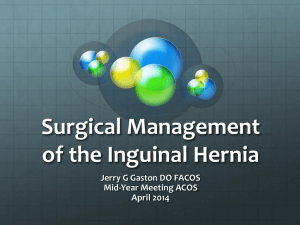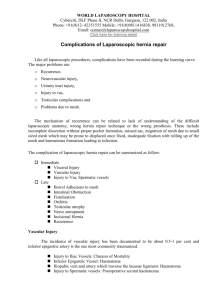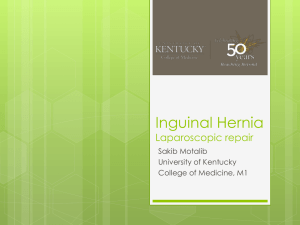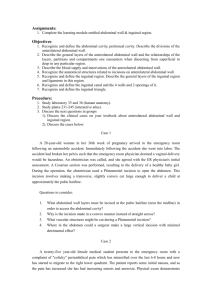Chapter13 - World Laparoscopy Hospital
advertisement
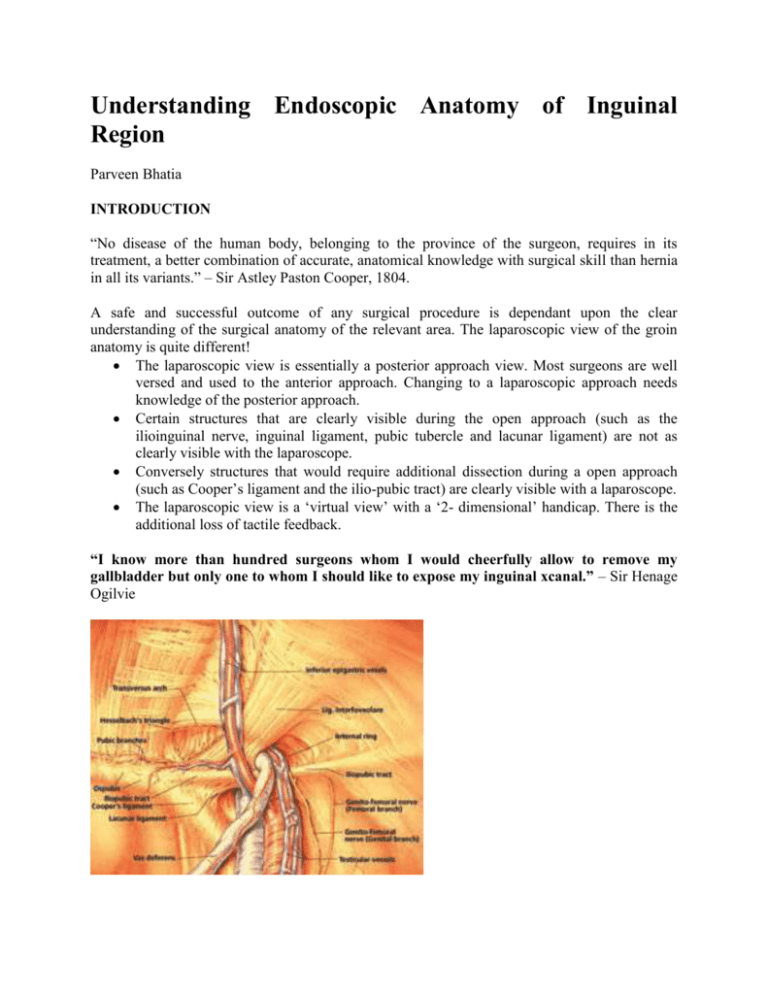
Understanding Endoscopic Anatomy of Inguinal Region Parveen Bhatia INTRODUCTION “No disease of the human body, belonging to the province of the surgeon, requires in its treatment, a better combination of accurate, anatomical knowledge with surgical skill than hernia in all its variants.” – Sir Astley Paston Cooper, 1804. A safe and successful outcome of any surgical procedure is dependant upon the clear understanding of the surgical anatomy of the relevant area. The laparoscopic view of the groin anatomy is quite different! The laparoscopic view is essentially a posterior approach view. Most surgeons are well versed and used to the anterior approach. Changing to a laparoscopic approach needs knowledge of the posterior approach. Certain structures that are clearly visible during the open approach (such as the ilioinguinal nerve, inguinal ligament, pubic tubercle and lacunar ligament) are not as clearly visible with the laparoscope. Conversely structures that would require additional dissection during a open approach (such as Cooper’s ligament and the ilio-pubic tract) are clearly visible with a laparoscope. The laparoscopic view is a ‘virtual view’ with a ‘2- dimensional’ handicap. There is the additional loss of tactile feedback. “I know more than hundred surgeons whom I would cheerfully allow to remove my gallbladder but only one to whom I should like to expose my inguinal xcanal.” – Sir Henage Ogilvie PURE ANATOMY The groin has a unique functional composite of musculo skeletal, visceral and neurovascular structures, the collective architecture of which serves to preserve the dynamic physiological integrity of the region. Breakdown of this functional barrier gives rise to hernia. ‘Deep’ repair of inguinal hernia addresses the issue of the ‘point of origin’ rather than the ‘point of presentation’. This practice has two important results. Firstly, the ‘inlay/ posterior’ mesh placement gives a mechanical advantage over the ‘onlay/ anterior’ mesh placement. Secondly covering the entire ‘Myopectineal orifice (of Fruchaud’) the ‘deep’ repair deals with all the potential sites at risk for herniation in the groin. THE ‘MYOPECTINEAL ORIFICE OF FRUCHAUD’ In 1956, Henry Fruchaud espoused the theory that all groin (inguinofemoral) hernia originate in a single weak area called the Myopectineal orifice. This oval, funnellike, ‘potential’ orifice formed by the following structures, forms the ‘Myopectineal orifice of Fruchaud’. • Superiorly Internal oblique and transverses abdominis muscles. • Inferiorly Superior pubic ramus. • Medially Rectus muscle sheath. • Laterally Iliopsoas muscle. Weakness through this area leads to inguinofemoral hernia. Proper exposure of this area is important during a preperitoneal (posterior) repair! To avoid missing small hernia as well as To achieve adequate fixation. The orifice is divided by the Iliopubic tract and the inguinal ligament into an ‘inguinal’ defect and a ‘femoral defect’. THE PERITONEAL LANDMARKS Since the development of the laparoscopic approach for the treatment of groin hernia an increased attention is being paid to ‘pure anatomy’ issues such as the infraumbilical fossae. These fossae have two important roles1. The fossae delineate the sites of groin herniation. 2. They are an important landmark for orientation during hernia repairs. The fossae are created by the presence of peritoneal folds, which radiate from the umbilicus or umbilical area. Median Umbilical Ligament This ligament ascends in the median plane from the apex of the bladder to the umbilicus. It represents the obliterated allantoic duct and its lower part is the site of the rare urachal cyst. Medial Umbilical Ligament This ligament represents the obliterated umbilical artery on each side and can be traced down to the internal iliac artery. Lateral Umbilical Ligament It is the ridge of peritoneum, which is raised by the Inferior Epigastric artery and its companion two veins as they course around the medial border of the internal inguinal ring and then pass upwards into the posterior rectus sheath. These ligaments delineate the following fossae Supravesical fossae The infra-umbilical area between the median and medial umbilical ligaments. This is the site for the origin of the supravesical hernia. Medial Umbilical fossae The infra-umbilical area between the medial and lateral umbilical ligaments. This is the site for the ori- gin of the femoral and direct inguinal hernia. Lateral Umbilical fossae The infra-umbilical area lateral to the lateral umbilical ligament. This is the site for the origin of the indirect inguinal hernia. THE AREA AT RISK Hesselbach’s (Inguinal) Triangle Franz Caspar Hesselbach’s (1759-1816) original descriptions of the inguinal triangle were as follows: • Superolateral boundary Inferior Epigastric vessels • Medially Rectus sheath • Medially Rectus muscle sheath. • Inferiorly Cooper’s ligament (Inguinal ligament in subsequent modification, to assist an ‘anterior’ approach surgeon.) This ‘at-risk’ area was predisposed to the formation of direct inguinal and femoral hernia! THE PREPERITONEAL SPACE Understanding of the preperitoneal space and its extensions is crucial to the laparoscopic surgeon. The significance of the preperitoneal space lies in the fact that all posterior approaches for the repair of groin hernia have to traverse this area and work in it. Embryology The genesis of the preperitoneal space occurs in concert with the global development of the abdominal wall. Transversalis Fascia (of Gallaudet) The current understanding of the preperitoneal (properitoneal / extraperitoneal / pareitoperitoneal) space is tied up intrinsically with the anatomy of the transversalis fascia in the infraumbilical region. The current understanding of the transversalis fascia envisages this fascia as a two layered (bilaminar) structure (confirmed by the laparoscope). Superiorly, the two layers of the transversalis fascia are two distinct entities and inferiorly they insert onto the Cooper’s ligament. The anterior layer is adherent to the rectus abdominis muscle. The posterior layer lies in between the anterior layer and the peritoneum. It divides this space into an anterior (vascular space) and a posterior (Space of Bogros). The old concept envisaged the transversalis fascia as being single layered (unilaminar). The transversalis fascia is now not believed to provide the kind of significant strength and integrity to the groin as earlier believed. Most importantly, it bridges the space between the transverses abdominis arch superiorly and the inguinal ligament and the Cooper’s ligament inferiorly. This crucial area is the “Achille’s heel” of the groin! It is here that direct inguinal herniation occurs. Condensations of the transversalis arch form three (3) named structures in this area. Interfoveolar Ligament This condensation of the transversalis fascia, whose fibresare oriented in a vertical direction in comparison to the rest of the fascia, forms the medial margin of the internal inguinal ring. It has no significant strength. Iliopubic Tract The Iliopubic tract is a thickened lateral extension of the transversalis fascia, which runs from the superior pubic ramus to the iliopectineal arch and the anterior superior iliac spine. The iliopubic tract is distinct from the inguinal ligament, although intimately associated with the inguinal ligament with which it is often confused! It is anterior to the Cooper’s ligament and posterior to the inguinal ligament. The iliopubic tract separates the internal ring from the femoral canal. It is visualized as a fibrous (white) tract. It varies in constancy! In only 28% of (open) groin hernia repairs was it found to be above average in density and formed a very strong aponeurotic band. Its significance in the laparoscopic hernia repair lies in the fact that it forms the superior boundary for the ‘Triangle of Pain’, in which lie the nerves of the ilioinguinal region, which are at risk for injury/ entrapment if anchoring of the mesh is performed below the iliopubic tract! Therefore: Laterally, staples / tacks should never be placed below the level of the iliopubic Iliopectineal Arch This is a thickened, tough, fascial structure covering the iliac muscle arches from the anterior superior iliac spine inferiorly to the Iliopubic eminence. It gives origin to a portion of the internal oblique and transversus abdominis muscle as well as the inguinal ligament. It is an important structure as it is a key supporting structure of the lateral groin! Boundaries of the preperitoneal space Anteriorly Posteriorly - Anterior layer of the transversalis fascia The peritoneum. Laparoscopic surgeon should work in the preperitoneal space ie. In the posterior space of Bogros to prevent unnecessary oozing. ‘Space of Bogros’ This ‘preperitoneal space’ is divided into two by the posterior lamina of the transversalis fascia. The posterior compartment has been now termed as the ‘Space of Bogros (proper)’, described by French anatomist Bogros in 1923. The anterior space has been termed as the ‘Vascular Space’. In some places the posterior lamina is deficient (eg. At the deep inguinal ring), there the peritoneum adheres to the anterior lamina. Medially it is continuous with the space of Retzius. ‘Prevesical space of Retzius’ The preperitoneal space that lies deep to the supravesical fossa and the medial umbilical fossa is the Prevesical space of Retzius (described in 1858, by Swedish anatomist Retzius). This space contains loose connective tissue and fat. Dissection of this space during a laparoscopic hernia repair is mandatory to enable proper mesh overlap of the hernial defect to aid in proper mesh placement/ fixation. Important vascular structures in this space are: 1. Normal and aberrant obturator vessels 2. Accessory pudendal vessels (10%) Contents (preperitoneal space) The preperitoneal space is filled up with a variable amount of connective tissue, fat, vessels, nerves and various viscera. The contents are listed below. VESSELS IN THE INGUINAL REGION There are numerous blood vessels coursing the inguinal region and the surgeon needs to be familiar with them to avoid iatrogenic injury and potentially devastating complications. Care has to be paid also to some minor vessels whose importance should not be underestimated. The following description gives the essential details of the vessels in this area. THE EXTERNAL ILIAC VESSELS The external iliac artery and vein lie on the medial aspect of the psoas muscle and course deep to the Iliopubic tract to form the femoral vessels. External Iliac Artery This artery gives off two branches within its distal two (2) cms. 1. Laterally – It gives off the Deep Circumflex Iliac artery, which courses along the iliacus muscle, deep to the Iliopubic tract, putting it at risk for injury during suturing or stapling. It then perforates the transverses abdominis muscle and ascends between the internal oblique and transversus muscles and supplies blood to both muscles. Here they complete an anastomotic circle by joining the iliolumbar and superior gluteal vessels. 2. Medially – It gives off the Inferior Epigastric artery. Near its takeoff the Inferior Epigastric artery gives off two branche. Cremasteric branch This vessel penetrates the transversalis fascia and joins the spermatic cord. Pubic branches The anastomotic pubic branches course in a vertical fashion inferiorly, crossing the Cooper’s ligament and anastomosing with the obturator artery at the obturator foramen. The Inferior Epigastric artery also gives rise to anterior pubic artery, which accompanied with the Iliopubic vein crosses the superior pubic ramus. In 25-30% (some studies mention as high as 70-80%) of individuals, the anterior pubic branch is large and can replace the obturator artery (Obturator artery originating from the Hypogastric artery is missing). This large arterial branch (Aberrant obturator artery) can partially encircle the neck of a hernia sac and be injured in a femoral hernia repair. It could also be injured while exposing the Cooper’s ligament by freeing it of areolaradipose connective tissue. Because of this possibility the whole anastomotic ring has in the past been known as the – ‘Corona Mortis.” The Inferior Epigastric artery ascends to anastomose with branches of the Superior Epigastric artery. External Iliac Vein The vein is medial and posterior to the artery. It receives comparable tributaries. The Inferior Epigastric vein is paired, however, and joins the external iliac vein about 1cm proximal to the takeoff of the Inferior Epigastric artery and is thus predisposed to injury. The Inferior Epigastric vessels cross over the Iliopubic tract at the medial aspect of the internal ring and ascend along the posterior surface of the rectus muscles, invested in a fold of peritoneum called the lateral umbilical ligament. Testicular Vessels These vessels arise from the aorta just below the renal arteries at L2 level. These follow the ureter caudally on its lateral border and then course along the lateral edge of the external iliac artery, cross the Iliopubic tract and join the spermatic cord at the lateral aspect of the internal ring. Anastomoses between the testicular, differential and cremasteric arteries supply the testicle with rich collateral circulation. The pampiniform plexus drains into testicular veins. The testicular veins drain into the inferior cava on the right and the renal vein on the left. Deferential vessels The deferential artery arises from the inferior vesicle artery, forming a microvascular network with the adventitia of the vas deferens. The deferential veins drain into the pampiniform plexus and vesical plexus. Deep venous circulation of the preperitoneal space (Bendavid) The venous circle/ deep venous circulation of Bendavid is located at the subinguinal space of Bogros. It is a network of deep inferior epigastric, rectusial, suprapubic and retropubic veins. A familiarity with these relatively underestimated vessels is important for surgeons working in the preperitoneal space! This is because damage to these vessels is easy and usually leads to haematoma formation. Iliopubic Vein This vein courses deeply to the Iliopubic tract and accompanies the anterior pubic branch when this is present. It either empties directly into the Inferior Epigastric vein or joins the venous anastomotic pubic branch to form a common trunk that drains into the Inferior Epigastric vein. Rectusial Vein (Bendavid) This vein runs along or is embedded within the lower lateral fibres of the rectus muscle. It forms (Bendavid) consistently a venous anastomotic ring by joining the Iliopubic vein above the pubic crest. Retropubic Vein This vein, a small collateral branch of the anastomotic pubic vein is commonly observed on the lower posterior aspect of the pubic ramus, beneath the Cooper pectineal ligament. NERVES IN THE INGUINAL REGION The important nerves in the groin region are the ilioinguinal, genitofemoral, lateral femoral cutaneous nerve and the femoral nerve. These nerves arise from the lumbar plexus, innervate the abdominal musculature and provide sensation for the skin and parietal peritoneum. Entrapment causes severe pain, whereas transection results in numbness. These nerves are variably visualized during laparoscopic hernia repair. Therefore, the surgeon must rely on knowledge of their normal anatomy and a ‘sixth sense’ to avoid injury. They do exhibit significant variation in their course! The following three (3) nerves are at risk for injury at laparoscopic hernia repair1. Lateral Femoral Cutaneous Nerve 2. Femoral Branch of the Genito-Femoral Nerve 3. Intermediate Cutaneous Branch of the Anterior Branch of the Femoral Nerve The following three (3) nerves are usually not at risk at laparoscopic hernia repair but can be injured if excessive pressure is applied during mesh fixation, compressing the muscles enough to allow the staples to reach the nerve. It is interesting to note that conversely the below three nerves are at most risk in open hernia repairs. 1. Ilioinguinal Nerve 2. Iliohypogastric Nerve 3. Genital Branch of Genito-femoral nerve Communication between the Genito-femoral nerve and Ilioinguinal nerve is common. This results in overlap of sensory innervation, which can cause difficulties in diagnosing which nerve is involved in the complication. LATERAL FEMORAL CUTANEOUS NERVE This nerve is the most commonly injured nerve during laparoscopic hernia repair. Injury of this nerve may be common with inexperienced surgeons performing laparoscopic hernia repair. Course It arises from L2-3, emerges at the lateral edge of the psoas muscle, courses along the iliac fossa, lateral to the iliac vessels. It passes below or through the inguinal ligament, where it lies free in a fibrous tunnel 1cm to the medial side of the anterior-superior iliac spine. Broin et al detailed its course in cadavers and found it was a mean distance of 6.6 cms from the Inferior Epigastric vessels and 5.6 cms from the Internal Inguinal ring as it passes below the Iliopubic Tract. Area of supply Sensory supply to the upper lateral thigh. Common Site of Injury To avoid nerve injury/entrapment, dissection and stapling should be above the Iliopubic Tract. Post-Injury Pain Injury results in pain and numbness in the upper lateral thigh and is called ‘Meralgia Paraesthetica’. Sensory Changes Injury results in pain and numbness in the upper lateral thigh and is called ‘Meralgia Paraesthetica’. GENITOFEMORAL NERVE The femoral branch of the genito-femoral nerve is at risk of damage during laparoscopic hernia repair. Injury to the genital branch of the genito-femoral nerve occurs only if excessive pressure is applied during mesh fixation, compressing the muscles enough to allow the staples to reach the nerve. Injury could also occur to the genital branch of the genitor-femoral nerve by manouvres to reduce the sac of an indirect hernia. Area of supply Genital branch supplies the Cremaster Spermatic fascia and tunica vaginalis of the testis. In the female, this branch should be preserved because it is sensory to the labium majora. It is the efferent branch for the cremasteric reflex. Femoral branch is the cutaneous branch to The skin over the femoral triangle (Anteromedial thigh). It is the afferent branch for the cremasteric reflex. Common site of entrapment Posterior abdominal wall, femoral or inguinal region. Post-injury pain Groin, scrotum and upper thigh. Sensory changes Hyperalgesia. Point tenderness 1. Internal inguinal ring. 2. Along Inguinal canal. Hip joint movement 1. Hyperextension or external rotation of hip increases pain. 2. Walking exacerbates the pain. Motor signs 1. Loss of cremasteric reflex. 2. Ejaculatory dysfunction. FEMORAL NERVE The intermediate cutaneous branch of the anterior branch of the femoral nerve is at risk during laparoscopic hernia repair. Injury to the femoral nerve has also been described in literature. Course The femoral nerve arises from L2-4, emerges from the lateral aspect of the psoas muscle and travels below the inguinal ligament, lateral to the femoral artery (outside the femoral sheath), to divide into sensory and motor branches. Area of supply Supplies the area (sensory) around the medial and intermediate aspects of the upper thigh. Motor supply is to the quadriceps. Common site of injury Posterior abdominal wall posterior to the inguinal ligament. Post-injury pain Over the groin, anterior and medial thigh. Sensory changes Hyperalgesia or dysthesia. Point tenderness None. Hip joint movement Minimal hip extension increases pain. Motor signs Quadriceps muscle weakness and atrophy and loss of patellar reflex. ILIOINGUINAL NERVE Entrapment of the Ilioinguinal nerve is unusual during Laparoscopic hernia repair and only is entrapped / injured if excessive pressure is applied during mesh fixation, compressing the muscles enough to allow the staples to reach the nerve. Course This nerve is smaller than the Iliohypogastric nerve. It arises from L1. It courses retroperitoneally across the quadratus lumborum behind the kidney and then passes anterior to the upper part of the iliacus muscle. It then pierces the transverses abdominis near the anterior end of the iliac crest. Then it pierces the internal oblique, travels through the inguinal canal in front of the spermatic cord and exits through the superficial inguinal ring or the adjacent external oblique aponeuorosis. Area of supply Supplies the 1. Skin at the root of the penis. 2. Anterior third of the scrotum (males). 3. A small area of thigh below the medial end of the inguinal ligament. 4. Labia majora (females). 5. Motor supply to the abdominal musculature. Common site of entrapment Common site of entrapment/ injury is medial to the anterior superior iliac spine. [Is only entrapped/ injured if excessive pressure is applied during mesh fixation, compressing the muscles enough to allow the staples to reach the nerve.] Post-injury pain Injury causes pain and burning (paraesthesia) in the lower abdomen (area mentioned in ‘Area of supply’.) Sensory changes Hypoalgesia or hyperalgesia. Point tenderness 1. Medial to anterior iliac spine. 2. Anterior abdomen. Hip joint movement 1. Limitation of internal rotation. 2. Extension of hip increases pain. Motor Signs Abdominal muscle weakness. ILIOIGHYPOGASTRIC NERVE Entrapment of the Ilioihypogastric nerve is unusual during Laparoscopic hernia repair and only is entrapped/injured if excessive pressure is applied during mesh fixation, compressing the muscles enough to allow the staples to reach the nerve. Course It arises from T12 and L1. It emerges from the lateral edge of the psoas muscle and crosses in front of quadrates lumborum behind the lower pole of the kidney. It perforates the transverses abdominis above the iliac crest and gives off a lateral cutaneous branch. The main nerve then pierces the internal oblique immediately above and in front of the anterior superior iliac spine. It then runs deep to the external oblique, just superior to the inguinal canal. It then penetrates the external oblique muscle within 1-2 cms of the superomedial aspect of the external ring. Area of supply 1. It supplies the skin in the suprapubic region with sensory fibres. 2. The lateral cutaneous branch supplies the skin over the posterolateral gluteal region. 3. It also provides the afferent and efferent path- ways for the abdominal reflex whereby stroking the skin in the suprapubic area produces contraction of the rectus abdominis musculature. Common site of entrapment Common site of entrapment/ injury is medial to the anterior superior iliac spine. [Is only entrapped/ injured if excessive pressure is applied during mesh fixation, compressing the muscles enough to allow the staples to reach the nerve.] Post-injury pain Injury causes pain and burning (paraesthesia) in the same area. Sensory changes Hypoalgesia or hyperalgesia. Endoscopic Anatomy of Defects (Trans-abdominal View) Point tenderness Medial to anterior iliac spine. Suprapubic area. Motor signs Weakness of the lower abdominal wall APPLIED ANATOMY ANATOMICAL LANDMARKS Anatomical landmarks are a surgeon’s guideposts. A procedure, wherein the surgeon cannot locate the relevant anatomical landmarks, renders the procedure unsafe mand condemned to a poor outcome. In the following description, the surgical anatomy is described from the viewpoint of a surgeon performing a TAPP (Trans-Abdominal Pre-Peritoneal) groin hernia repair. However, all the structures and entities described below are also visualized in a TEP procedure. Thus, the incumbent surgeon is mandated by need, to know and understand the below described structures! The reader is reminded that in the performance of a TEP (Total Extra Peritoneal) groin hernia repair,the initial balloon dissection occurs in the space of Bogros medially and finally medio-inferiorly in the vicinity of the pubic symphisis. Thus all the below described structures (Phase I) will appear without the ‘initial’ benefit of the peritoneum covering them. Blunt dissection in the space of Bogros initially reveals areaolar / fattyareolar tissue with relatively minimal vascularity. The pubic symphisis is visualized as a white bony structure. LANDMARKS FOR TRANSABDOMINAL PREPERITONEAL HERNIA REPAIR (TAPP) PHASE - I Inguinal Anatomy with the peritoneum intact With the introduction of the laparoscope into the abdomen, 5 (five) important landmarks will need to be identified in the infra-umbilical region! Inferior Epigastric vessels Medial Umbilical Ligament Spermatic vessels Vas Deferens Trapezoid of Disaster 1. Inferior Epigastric vessels The Inferior Epigastric artery is prominently visualized during laparoscopic preperitoneal dissection of groin hernia. Implication It forms the lateral border of the Hasselbach’s triangle. Identifying these vessels differentiates between direct and indirect inguinal hernia. Bleeding from an ‘injured’ Inferior Epigastric artery can be quite brisk. Identification A small calibre vessel, it arises proximal to the inguinal ligament from the external iliac artery, ascends in a medial direction on the anterior abdominal wall toward the lateral border of the ipsilateral rectus muscle, running between the two lamellae of the transversalis fascia. Visualisation The artery is most prominent close to its origin from the external iliac artery at the medial margin of the internal ring. Fat may obscure these vessels in obese patients. 2. Medial umbilical ligament (Obliterated Umbilical Artery) Implication Can be confused with the inferior epigastric artery! DO NOT dissect medial to it during a TAPP procedure! Medial dissection to the medial umbilical ligament would put the urinary bladder at risk to injury. Identification It courses from the Internal iliac artery as its last branch towards the umbilicus. It becomes apparent midway between the internal ring and Cooper’s ligament. Visualisation It is made apparent by its mesentery. It can be differentiated from the inferior epigastric artery by its course toward the umbilical trocar, whereas the inferior epigastric vessels are directed toward the lateral border of the rectus. 3. Spermatic vessels Implication Forms the lateral border of the ‘triangle of doom’ andthe medial border of the ‘triangle of pain’. Identification The testicular artery and vein descend caudally in the retroperitoneum and enter the internal ring on its posterior aspect from a craniad direction. They travel directly over or slightly lateral to the external iliac artery and vein and are joined by the vas deferens before entering the ring. Visualisation Easily visualized as they are covered only by peritoneum. 4. Vas deferens Implication Forms the medial border of the ‘triangle of doom’ and ‘quadrangle of disaster’. Identification From the internal ring, it can be traced medially as it curves over the pelvic brim to disappear behind the bladder. It joins the testicular vessels before entering the internal ring from an inferior and medial direction. Visualisation Easily visualized as it is covered only by peritoneum. 4. ‘Trapezoid of Disaster’ (Labeled by Seid) Implication Lying beneath the peritoneum and transversalis fascia (within this triangle) are the external iliac artery and vein and may be damaged with serious consequences! No dissection should take place in this area! No staples should be placed in this area! Identification It is formed by the meeting of the vas deferens and the testicular vessels at the internal ring, which forms the apex of the triangle. Visualisation Easily identifi ed and visualized as the vas deferens and the testicular vessels are covered only by peritoneum. 6. ‘Triangle of pain’ Implication It describes the area in which the femoral branch of the genitofemoral nerve, the lateral femoral cutaneous nerve and femoral nerve lie. If a surgeon uses staples, he must avoid using it in this area! Identification It is bound inferomedially by the gonadal vessels and superolaterally by the iliopubic tract. Visualisation The ‘triangle’ is easily distinguished as it’s borders are recognized easily. (The iliopubic tract is more readily recognized after the peritoneal flaps are raised.) PHASE – II Inguinal anatomy with the peritoneum incised After the peritoneum is dissected away, 4 (four) additional structures need to be identified. They are: Internal Inguinal/ Spermatic ring Iliopubic tract Cooper’s ligament Femoral Canal 1. Internal Inguinal / Spermatic ring Implication Denotes the site of origin of an indirect inguinal hernia. Identification The most reliable indicator of the internal ring is the junction of the testicular vessels and the spermatic cord. The inferior border is bound by the iliopubic tract. Visualisation The appearance of the ring varies depending on the hernia defect. Sometimes the ring is made prominent by the pneumoperitoneum. 2. Iliopubic tract The Iliopubic tract is thickened lateral extension of the transversalis fascia, which runs from the superior pubic ramus to the iliopectineal arch and the anterior superior iliac spine. Implication The iliopubic tract separates the internal ring from the femoral canal. The iliopubic tract is distinct from the inguinalligament, although intimately associated with the inguinal ligament with which it is often confused! Laterally, staples/ tacks should never be placed below the level of the iliopubic tract! Identification It originates laterally from the iliopectineal fascia and the anterosuperior iliac spine and inserts into the superior pubic ramus lateral and superior to the Cooper’s ligament. It is anterior to the Cooper’s ligament and posterior to the inguinal ligament. Visualisation It is visualized as a fibrous (white) tract. 3. Cooper’s ligament This ligament is a condensation of the transversalis fascia and periosteum located lateral to the pubic symphisis. It is several millimeters thick, densely adherent to the pubic ramus and joins the Iliopubic tract and lacunar ligaments at their medial insertions. Implication This ligament is used to anchor the mesh initially. Identification It takes a curvilinear course medial and inferior to the insertion of the iliopubic tract to form the prominence of the pelvic brim anteriorly. The Cooper’s ligament can readily be palpated as a thick, strong fibrous band and is shiny when freed from surrounding fat and soft tissue. It is visualized as a fibrous (white) curvilinear structure. Visualisation The Cooper’s ligament is readily visible when adipose tissue does not cover it. Otherwise, visualisation needs it to be freed of surrounding adipose tissue. CAUTION Mobilising adipose tissue around the Cooper’s ligament can injure an aberrant obturator artery, which might course over it. Injury to this vessel results in distressing bleeding. This unfortunate morbidity has resulted in the naming of this vessel as - ‘Crown of Death’/ ‘Corona Mortis’. ‘CORONA MORTIS’ / CROWN OF DEATH / CIRCLE OF DEATH The pubic branch of the Inferior Epigastric artery courses in a vertical fashion inferiorly, crossing the Cooper’s ligament and anastomosing with the obturator artery. In 25-30% of individuals (can be as high as 7080%), the pubic branch is large and can replace the obturator artery. This large arterial branch (Aberrant obturator artery) can partially encircle the neck of a hernia sac and be injured in a femoral hernia repair. It could also be injured while exposing the Cooper’s ligament by freeing it of areolar-adipose connective tissue. Because of this possibility an enlarged pubic branch of the Inferior Epigastric artery has in the past been known as the – ‘Corona Mortis’. The danger of injury in this area is more significant for obturator veins. 6. Femoral canal Implication It denotes the potential site of origin of a femoral hernia. Identification The canal lies posterior to the iliopubic tract. The anterior border is formed by the inguinal ligament, the medial border by the lacunar ligament, the posterior border by the pectineal ligament and the lateral border by the femoral vein. Visualisation It is a potential space (in the absence of a femoral hernia). TECHNICAL ISSUES RELATING TO LAPAROSCOPIC SURGICAL ANATOMY Issues Relating To Exposure / Visualisation Any hernia above the iliopubic tract is an inguinal hernia and one below is a femoral hernia. The inferior epigastric artery should be accurately differentiated from the obliterated umbilical artery to help differentiate direct from indirect inguinal hernia. The dissection should expose the following structures Cooper’s ligament Iliopubic tract Testicular vessels Internal ring Spermatic cord Musculo-aponeurotic transverses abdominis arch. The preperitoneal tissue should be completely elevated along the peritoneum to reach the correct plane (Space of Bogros). Dissection outside this space leads to bleeding Issues Related To Dissection Dissection in the ‘Trapezoid of Disaster’ must be avoided!!! While dissecting around Cooper’s ligament, take care to avoid injury to the branches of the obtu- rator vein. Issues Related To Fixation of Mesh Staples or sutures should not be placed lateral to the cord or below the iliopubic tract (Trapezoid of Disaster) to avoid injury to the branches of the genitofemoral nerve and the lateral femoral cutaneous nerve. Staples should not be placed lateral to the inter- nal ring in the endopelvic fascia to avoid injury to the ilioinguinal nerve. Cooper’s ligament should be properly exposed as the initial fixation is performed to this structure. REFERENCES Embryology, anatomy and surgical applications of the preperitoneal space; Kingsnorth et al; Surgical Clinics of North America; Vol. 80, No. 1, February 2000; pp 1–24. The inguinofemoral area from a laparoscopic stand- point: History, Anatomy and Surgical Application; Avisse et al; Surgical Clinics of North America; Vol. 80, No. 1, February 2000; pp 35–48. A selective history of Groin Hernia Surgery in the Early 19th century: The anatomic atlases of Astley Cooper, Franz Hesselbach, Antonio Scarpa and Jules-Germain Cloquet; Ira M. Rutkow; Surgical Clinics of North America, Vol. 78, No. 6, December 1998; pp 921–940. Abdominal wall and hernias; Surgical Anatomy and Technique: A Pocket Manual; J.E. Skandalakis, P.N. Skandalakis, LJ Skandalakis; 2nd edition, Springer 2000; Chapter 4, pp 123–155. Surgical Anatomy of the Inguinal Region and lower Abdominal Wall from the Laparoscopic Perspective: Special Comment; Ricardo G. Annibali; Hernia (Textbook); Nyhus, Condon; 4th edition; pp 64–72. Laparoscopic Hernia Repair; Mark A. Talamani and Chandrakanth Are; Shackleford’s Surgery of the Alimentary Tract; George D. Zudeima and Charles J. Yeo (Ed); W.B. Saunders Company 2002; 5th Edition, Vol. 5, Chapter 12, pp 137–149. Hernias and Abdominal Wall defects; Daniel J. Scott and Daniel B. Jones; Surgery: Basic Science and Clinical Excellence; Norton, Bollinger, Chang, Lowry, Mulvihill, Pass, Thompson (Ed); Springer2000; pp 137–149. Classification systems and groin hernia; Rutkow and Robbins; Surgical Clinics of North America, Vol. 78, No. 6, December 1998;pp 1117–1127. Surgical anatomy of the inguinal region; Irving Lichtenstein; Hernia Repair without Disability; Irving Lichtenstein, 2nd edition, Ishiyaku Euroamerica Inc. 1986; pp 18–40. Michael S. Kavic ;Rationale for Laparoscopic Hernioplasty; Chapter 3, pp 33–40; Laparoscopic Hernia repair (Text Book); Harwood Academic Publishers, 199. ACKNOWLEDGEMENTS I thank Dr. Suviraj John, Consultant Laparoscopic Surgeon who spent a lot of effort and time in drawing the illustrations for Laparoscopic Hernia Repair: Step by Step approach. I also thank Dr. Tarun Jain, Consultant Surgeon, who has given an indefatigable effort in editing this chapter.

